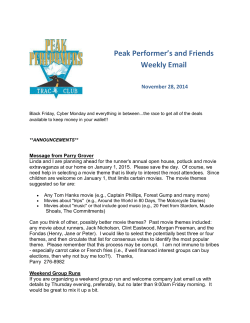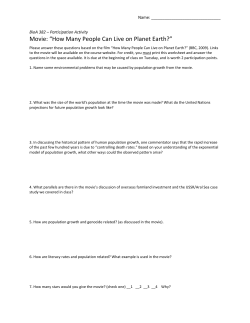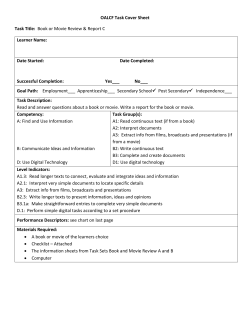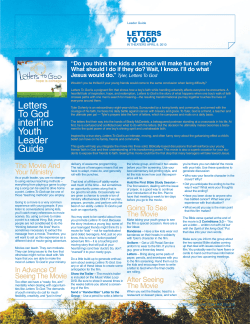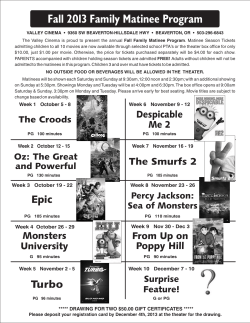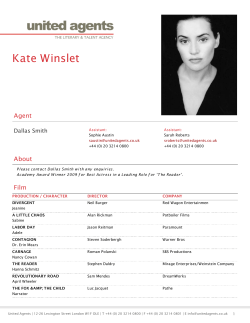
Q–&–A Ryan Trecartin & James Franco All-American Golden Boy 138
Q–&–A Ryan Trecartin & James Franco All-American Golden Boy Roamie View: History Enhancement (Re’Search Wait’S), 2009-2010 Background: Ready (Re’Search Wait’S), 2009-2010 Another Man 138 138 All images courtesy of the artist and Elizabeth Dee, New York I-Be Area, 2007 Ryan Trecartin makes films. Overwhelming, intricate, mesmerising films filled with deranged worlds, hysterical characters and a lot of make-up. Films that make you lose your grip on reality and, as Hollywood star and Trecartin fan James Franco discovers, films that might glimpse the future… Another Man 139 139 K-CoreaINC.K (section a), 2009 Sibling Topics (section a), 2009 Another Man 140 Spring 2005. Artist Sue de Beer is doing her visiting lecturer rounds at Cleveland Institute of Art when a student shows her a five-minute video clip he’s discovered on www. friendster.com. The film opens on a young girl called Lisa as she visits her demonic drag-clown friend hiding in a cupboard. It gets weirder. Lisa then opens a small box: inside, day-glo patterns disintegrate into neon spirals that morph to form a hundred micro-worlds before detonating into palm trees, floating anatomical fi gures and tropical fl owers – or are those hearts? Skippy – a boy in a vest, badly gelled hair and black teeth – stares in a bathroom mirror, turns from red to orange and back again, cuts up Polaroids, flushes the pieces down the toilet and starts carving himself up with an enormous kitchen knife while squealing, “Somewhere there is something worth dying for and I think it’s amazing!” A smiley face swims by… De Beer is hooked. With the help of her curator friend Rachel Greene, de Beer traces the film to a profi le page belonging to Ryan Trecartin. They email him. 22-year-old Trecartin – a recent graduate in Video, Film and Animation from the Rhode Island School of Design – explains that the clip is from his 41-minute movie A Family Finds Entertainment, made in 2004 with his friends in their shared house in New Orleans. He sends Greene the full version, which she promptly shows to NYC gallerists. Five years later and Trecartin is an award-winning global sensation working at the forefront of digital art and still posting his films online ( w w w. y o u t u b e . c o m / u s e r / Wi a n Treetin). He’s just moved back to LA – after Hurricane Katrina, Trecartin and his troupe escaped to Ohio, LA, Philadelphia and Miami – and is searching for “a big, rundown space for cheap”. He’s putting the finishing touches to the US premiere of his Any Ever exhibition at the Museum of Contemporary Art in west Hollywood. And, today, he’s “super excited” because James Franco – who, having seen Trecartin’s The Generational: Younger Than Jesus show last year, has been obsessed with his work ever since – is on the phone from Vancouver... JAMES FRANCO: Did you make things as a kid? RYAN TRECARTIN: When I was little I would always make costumes and sets with my friends and we would make situations but we would never document them. JF: Were they like sketches? RT: I don’t know what they were. I wanted them to be movies but they were much more like games – we’d make a set and then it’d be like, ‘These are the rules, this is the kind of scene it is and this is when two people maybe get into a fight.’ It wasn’t performed for anyone. JF: What was inspiring you back then… movies, television and, I guess, the internet? RT: It sounds cheesy but it was the way people responded to TV. I feel I was really affected by my babysitters, watching them get excited by some TV show and how it affected their lives and how it changed the way they talked and how it added to their language and those other forms of intelligence that exist, like body language and accents. It’s funny how everyone now is used to performing and translating ideas and using all forms of language, not just words. JF: The characters in your films wear some crazy make-up and wild clothes, and talk about themselves not as people but as ideas or companies… tell me where this concept of identity comes from? RT: I think the internet – and all its interactive elements – has been latent inside of us, like it’s a natural extension of who we are. I think we’re slowly moving to a point where we will visually manifest at the speed of creative thought, where as we’re saying an idea we are also changing our body and changing our scenery and all these different extensions of language. We could reach a point where personality defines you more than your gender, sexuality or career because nothing is fixed – it’s all a choice. And so accents, how we present ourselves and locate ourselves in these different spaces becomes really important. All these different things come together with interactivity through technology. There is the potential to unlock new realities that are already inside us. Trecartin & Franco 141 JF: Do you see this construction of self as a positive thing? RT: I’m not commenting on it in my movies, I’m just presenting it – exploring it. You know, a lot of the time terrifying aspects of our culture are really a symptom of something very positive that may be happening underneath. I think amazing things sometimes just seem superficial and negative at first because we have to change our moral codes before we can appreciate them properly. I’m really excited about the point when we can liberate ourselves from becoming more human. It’s kind of messed up, I know. (Laughs) JF: Are your films scripted or is there some improvisation? RT: It’s all scripted but it’s not very strict. Most of the scripts look like poems, I mean, there’s no stage direction or any storyboarding or anything like that. I might have the phrases but I don’t distinguish as to who is saying what – I figure it out as I go along. Because I work with a lot of untrained actors some of the most amazing parts of the movie aren’t scripted, they just happen while we’re shooting. Often when we have downtime on set people will stay in character – they’re still in a kind of trance – and then a lot of amazing moments happen that aren’t scripted because someone will say, ‘Oh, I need to be drunk,’ or ‘I have to have a Red Bull to keep doing this,’ and so then everything moves into this other reality where people are suddenly in real time and I don’t turn off the camera. They start exercising their personal needs but through the structure that’s slowly been glued to them during shooting; you know, it’s really easy to not act like yourself if you don’t look like yourself. Especially today when everyone is good at performing; everyone does it all the time. Irony and sincerity co-exist and people are really good at arranging intentions and speaking on multiple levels. JF: One of the interesting things is that a lot of the material is done directly to camera… RT: Yeah. I’m really interested in characters talking in first, second and third person at once, and also talking straight to the camera as themselves. That way, the audience like a weird in-between performing; is implicated. And as the performer between faking a different persona doesn’t know the full script there for reality TV and traditional acting. is this sort of openness to their face JF: Your performances in the that’s really interesting… movies are very good, you do a lot JF: So, you’re saying a lot of the of different characters and I think time the performers don’t know the they’re all really nuanced. Are these script even when you’re shooting? performances constructed during RT: Nobody working on the the editing process? movie ever sees the script until RT: It’s crazy how much changes afterwards. I really like that form of in editing. It definitely changes the directing where I know the script performances and from there I often but they only understand it as we’re throw away my original intentions going along. They’ll suddenly say, for a character because I realise it ‘Oh, I didn’t know this was what my can be steered in a completely character was about.’ That process different direction. And then there of them reviewing it slowly gets the are these moments when the performances I want. camera is still on and someone gives JF: How do you cast your films? someone else a dirty look or maybe RT: Well, up until my latest has a nervous twitch and I realise movies most have been friends, that there’s a whole other artists and family members – new moment and sometimes people I met that on the internet. I met a lot of my friends on the internet. But recently I’ve started to bring in more actors and TV people. JF: Did you contact them? “The internet has been latent inside all of us – RT: Well, I was it’s a natural extension of who we are” in Miami when I made this new group of movies called Re’Search Wait’S and there’s the Orlando Disney industry near there so there’s this one movie called can be used The Re’Search which features for that character’s all Orlando-based actors. We did a persona. But they’re being filmed so traditional casting for that, so none fast and the movie is being cut so of them were personal friends. It fast that a lot of the time you stop was really fun to direct the way I’ve seeing the cuts and you don’t realise grown to direct but with people that real footage and performed who hadn’t learnt to be directed like footage have been spliced together. that. When someone is trained to JF: I read an article where the act on TV they want to see the writer said that some of the worlds script and then when you don’t let you create left them feeling icky… them it’s really interesting. I think a what do you think about that? lot of them had a hard time with it, RT: When people feel icky about but in a fun way. the movies often it has to do with JF: When you’re working with the fact that the characters are actors who don’t know the script, constantly embarrassing themselves are you just reading them lines as (laughs). I mean, it’s not like they’re you’re going? shocking, they’re just not cool RT: It’s like, ‘Say this right now, (laughs). I feel like people who have and look this way and you’re angry.’ grown up with reality TV, which I Then they’re like, ‘Why am I angry?’ guess are people born in the 90s, (Laughs) ‘It doesn’t matter! Then are much more comfortable with run over here and turn around’… embarrassing themselves. You can it’s about the physicality. It’s kind of Another Man 142 perform an identity and it doesn’t have to actually be your identity. When you meet someone who is on a reality TV show, I feel like people know that the way they appear on TV isn’t necessarily who they are. We’re happy about that now and people are comfortable with having more faces of themselves that aren’t exactly flattering. I think it is really positive when people are no longer so embarrassed by certain things because it makes you freer to have more interactions. JF: How does audience reaction play into your subsequent work? RT: The intention of every movie comes from the reactions of people watching the last one. A positive response makes me want to make another film. If it’s negative then that inspires me to challenge what I was doing. I’m glad that both happen. I feel like I make this stuff for people so I think about the audience the entire time. The whole point for me is to share it. JF: Your films can be seen in parts on YouTube or in their entirety in gallery spaces… how do these two options change the experience? RT: Well, different aspects of content come out when you watch them in different kinds of exhibition spaces. If you’ve only seen it online, you haven’t seen it – you’ve only seen a version of it. But that’s legitimate. If you see it in a gallery, you walk in and it’s part of a viewing environment – and there are props there – so it puts you in a vibration between being in the movie and watching it through a frame. But if you were to see it in a movie theatre you’re watching it from beginning to end and you’re thinking about the whole structure, themes, the plot arc, the scenes – all the things we’ve been trained to understand. It becomes a cinematic sensation. I construct them with a beginning, a middle and an end so a movie theatre situation is best. The Re’Search (Re’Search Wait’S), 2009–2010 er e at ou r lv se es m fro exc ited abo ut wh en we ca n lib RT: Well, I’m obviously going to make a 3D movie (laughs). I’d like to make a surround movie with multiple screens that is an actual experience that you can walk into and use technology that allows the direction of the movies to change in relation to the audience’s response. I would also love them to be fully inter- “I’m JF: Oh, I didn’t know they are screened in movie theatres… RT: They’re playing at the silent movie theatre here in LA for two days and I’m really excited about that. They can function in the movie theatre and I’d love to see them play in them more but it’s hard. Especially because of the content: there isn’t permission for all the content because I just don’t know how that stuff works. Some movie theatres are like, ‘There’s a Disney font in there, do you have permission for that?’ JF: Yeah, I did notice a lot of Listerine. (Laughs) RT: (Laughing) I know, there are products everywhere. But I think a lot of those laws have to change because products have a lot of cultural meaning now. I believe that strongly. I don’t think a company should be allowed to use someone’s persona to advertise anything without their permission – I think I understand why that is wrong – but I feel like with a product, you should be able to use that. That’s just cultural content and that’s language. JF: How do you see your films changing with the development of technology? Trecartin & Franco active. So, you’d enter the fi lm online and curate your own experience. I think that TV, movies, games and the internet will blend into one format that is instant. 143 JF: If you ever have anything for me in one of your films let me know because I’m game for anything. RT: Okay. I definitely will. be in com re human” g mo JF: Great, thanks Ryan. Hope to see you very soon in LA. RT: Yeah, thanks James. Bye. Any Ever runs at MOCA Los Angeles until October 17. It then tours to three venues in 2011: MoMA/PS1 in New York, MOCA in north Miami and the Musée d’Art Moderne in Paris. Trecartin makes his London debut at the Frieze Art Fair from October 14 to 17 with screenings of Roamie View and Ready-two. His 2009 Trill-ogy Comp shows at the 2010 Liverpool Biennial running from September 18 to November 28
© Copyright 2025
